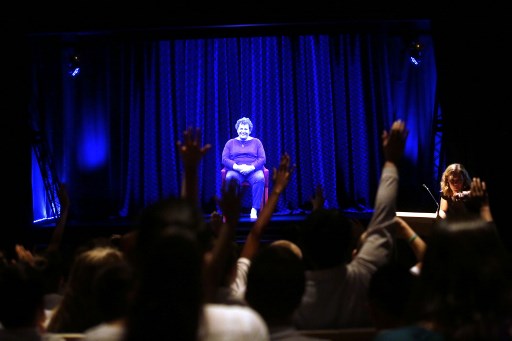

by Nova SAFO
Agence France-Presse
CHICAGO, United States (AFP) — Seated onstage at a museum near Chicago, Adina Sella talks about her life as a Holocaust survivor.
A group of young school kids is entranced — all the more so because Sella is not actually there.
Her likeness is being beamed in the form of an interactive and moving hologram, part of a first-of-its-kind exhibition debuting this weekend at the Illinois Holocaust Museum, which aims to preserve accounts of a fast-disappearing generation.
“She has their undivided attention,” teacher Samantha O’Neill of Chicago’s Northside Catholic Academy said.
“It really does look like she is sitting on the stage in front of you.”
The exhibit uses voice-recognition technology and machine learning to let visitors ask questions about survivors’ World War II ordeals and hear answers that grow more relevant with time, as the technology learns.
Thirteen Holocaust survivors, most living in the United States, but also from Canada, Israel and Britain, were recorded for the exhibit.
They answered thousands of questions, each sitting for about a week of high-definition video recording.
“It prepares us for the day when our survivors will not be here,” the museum’s chief executive Susan Abrams said.
The Nazis murdered some six million Jews, and millions of other people, in the Holocaust. As survivors age, organizations are grappling with the dilemma of how to preserve their stories.
Famed movie director Steven Spielberg in 1994 established a foundation that video recorded 55,000 testimonies of Holocaust survivors and witnesses.
His organization eventually became the Shoah Foundation, a part of the University of Southern California in Los Angeles. And it is that group that teamed up with the Illinois museum to create the holograms.
– Realistic interaction –
The project took nearly three years. Survivors were seated in the middle of a half dome studio filled with high-definition cameras and lights to capture them from multiple angles.
The finished product makes its world premiere Sunday, and offers a real-time conversation with the likeness of a survivor. Early tests of the $5 million exhibit have been encouraging, Abrams said.
“Audiences feel even more comfortable asking their questions to the hologram, because they’re not worried that they’re going to hurt somebody’s feelings or make them upset. And so, this has really been a powerful tool,” she said.
In the museum’s auditorium before Sunday’s debut, dozens of elementary school children listened as Sella sat onstage in a red chair. The occasional sputter of her projected image was a reminder that she was not really there.
“How old are you now?” one child asked.
A museum facilitator repeated the question into a microphone, and the technology powering the hologram offered a corresponding answer, recorded in such a way that it would remain relevant forever.
“I was born December 1st, 1935, and so please figure out,” Sella answered with a heavy accent.
The children quickly did the math and realized she was 81.
– ‘Experienced globally’ –
The museum, as with other institutions dedicated to the Holocaust, still holds regular in-person talks with survivors — a group known as its “Speakers’ Bureau.”
One of the leaders of that group is Aaron Elster, who also was one of the first to sit through the hologram recording process.
“Most of us are concerned that within a short period of time when we’re gone, what happens,” Elster said.
Would survivors become a historical footnote, “or are we still alive, in essence, to tell people what happened?”
“We feel it’s really important. We want our families to be remembered,” he added.
The museum plans to eventually license the hologram project to other institutions, so they can also create exhibitions.
“We want this to be experienced globally,” Abrams said.
The institution emphasized that the holograms are merely a part of its exhibition entitled “Take a Stand Center.”
Geared toward school children, there are also touchscreen panels featuring historical and contemporary inspirational figures, among them Nelson Mandela of South Africa and teen activist Malala Yousafzai of Pakistan.
© Agence France-Presse
